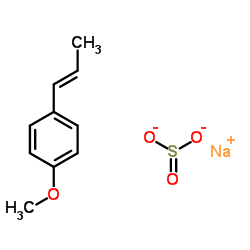

聚茴脑磺酸钠结构式

|
常用名 | 聚茴脑磺酸钠 | 英文名 | polyanetholesulfonic acid sodium |
|---|---|---|---|---|
| CAS号 | 55963-78-5 | 分子量 | 251.255 | |
| 密度 | N/A | 沸点 | 237.5ºC at 760 mmHg | |
| 分子式 | C10H12NaO4S | 熔点 | N/A | |
| MSDS | 中文版 美版 | 闪点 | 88.4ºC | |
| 符号 |

GHS07 |
信号词 | Warning |
|
Functional assessment of mouse complement pathway activities and quantification of C3b/C3c/iC3b in an experimental model of mouse renal ischaemia/reperfusion injury
J. Immunol. Methods 419 , 25-34, (2015) The complement system is an essential component of our innate immunity, both for the protection against infections and for proper handling of dying cells. However, the complement system can also contribute to tissue injury and inflammatory responses. In view ... |
|
|
Improved amplification of microbial DNA from blood cultures by removal of the PCR inhibitor sodium polyanetholesulfonate.
J. Clin. Microbiol. 36(10) , 2810-6, (1998) Molecular methods are increasingly used to identify microbes in clinical samples. A common technical problem with PCR is failed amplification due to the presence of PCR inhibitors. Initial attempts at amplification of the bacterial 16S rRNA gene from inoculat... |
|
|
Expanding the diagnostic use of PCR in leptospirosis: improved method for DNA extraction from blood cultures.
PLoS ONE 5(8) , e12095, (2010) Leptospirosis is a neglected zoonosis of ubiquitous distribution. Symptoms are often non-specific and may range from flu-like symptoms to multi-organ failure. Diagnosis can only be made by specific diagnostic tests like serology and PCR. In non-endemic countr... |
|
|
Use of the RapID-ANA system and sodium polyanetholesulfonate disk susceptibility testing in identifying Haemophilus ducreyi.
J. Clin. Microbiol. 28(1) , 108-11, (1990) Haemophilus ducreyi has traditionally been difficult to identify. We have utilized simple test methods to identify 19 fresh isolates obtained during a recent outbreak of chancroid in Houston and six strains of H. ducreyi from other outbreaks. Tests were perfo... |
|
|
Poor performance of BACTEC NR 730 blood culture system in early detection of Neisseria meningitidis.
J. Clin. Microbiol. 27(4) , 654-6, (1989) During an 8-month period at Children's Hospital, Oakland, Calif., a 9% rate for positive blood culture for children with Neisseria meningitidis meningitis was identified. The blood culture system used in each case was the BACTEC NR 730. This rate seemed signi... |
|
|
Isolator component responsible for inhibition of Mycobacterium avium-M. intracellulare in BACTEC 12B medium.
J. Clin. Microbiol. 35(3) , 588-90, (1997) We previously reported an inhibitory effect on Mycobacterium avium-M. intracellulare (MAI) when blood collected and processed with the Isolator system was placed in BACTEC 12B bottles for radiometric monitoring. We sought to identify the specific component(s)... |
|
|
Controlled evaluation of trypticase soy broth with and without gelatin and yeast extract in the detection of bacteremia and fungemia
Diagn. Microbiol. Infect. Dis. 8(1) , 19-24, (1987) The addition of gelatin to blood culture media has been suggested to prevent the inhibition of Neisseria meningitidis , Neisseria gonorrhoeae , Gardnerella vaginalis , and Peptostreptococcus anaerobius that is caused by sodium polyanetholsulfonate. To determi... |
|
|
Salt-induced cell lysis of Staphylococcus aureus.
Curr. Microbiol. 30(5) , 299-303, (1995) Cell lysis was efficiently induced in Staphylococcus aureus by the addition of 0.3 M NaCl to exponentially growing cultures at 30 degrees C. When cells harvested at the exponential phase were incubated in buffer with NaCl, autolysis occurred. Treatment with c... |
|
|
Selective inhibition of human natural killing and antibody-dependent cellular cytotoxicity by a polyanion.
Scand. J. Immunol. 25(5) , 507-15, (1987) A high molecular polyanion, Liquoid, was found to inhibit at nontoxic concentrations (12-50 micrograms/ml) the natural killing (NK) and the antibody-dependent cellular cytotoxic (ADCC) activity of human peripheral blood mononuclear cells selectively. Whereas ... |
|
|
Salt-induced L-forms of Staphylococcus aureus.
Microbiol. Immunol. 39(6) , 425-7, (1995) When growing cultures of a salt-sensitive strain of Staphylococcus aureus were inoculated on nutrient agar containing 0.8 M NaCl and 0.5% bovine serum albumin, typical colonies of L-form developed extensively after 2 days of incubation at 30 C. Incubation of ... |